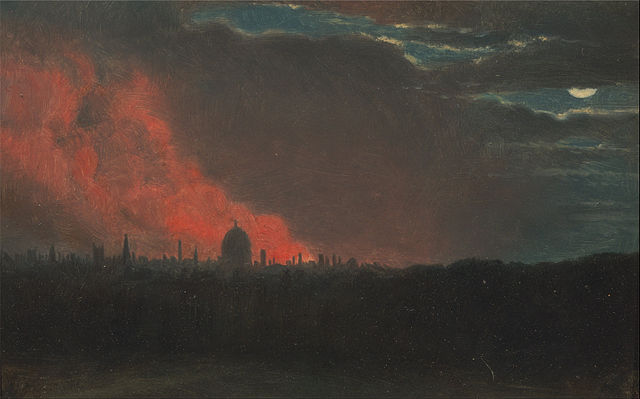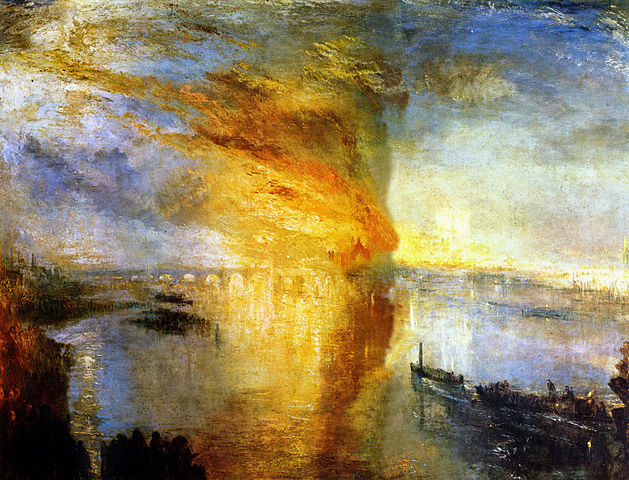|
KYSO Flash ™
Knock-Your-Socks-Off Art and Literature
|
|
|||
Constable and Turner: Touching Fireby Charles D. Tarlton
...with one’s face in the wind, you were almost burned with a shower of fire-drops. 1 On 6 November 1961, I was a graduate student at UCLA in California. Brush fires broke out in the canyons above Brentwood and Bel Air, the posh residential areas directly north of the University. The fires were soon out of control, burning hundreds of expensive homes in these elite areas. From a vantage on the roof of our building we could watch the progress of the fire. After dark, you could see fires work their way up and surround a house, and, in a minute, the house would explode and disappear. This happened over and over. I remember the lights of the city illuminating the underside of huge smoke clouds rising above the hills. Hot fragments from the fire were carried away on the wind and dropped down all over town. There was a constant wailing of sirens. the playful way fire helps identify the man running hot or cold whether you warm up to it or hold it at a distance the thing about fire is that it destroys and kills what the painter sees however is just the light how it illuminates things Burt Lancaster’s house gone up in flames, Lawrence Welk climbing on the roof with a hose, celebrities their humanity exposed 2 Here is where the contrast between Turner and Constable seems most evident—in the use of color and the light. Turner, brash and torrential, tried to catch the essence of the flames, how they reached to set the whole of the world on fire. Turner’s fire is gnawing at his clouds. Constable, precise and scientific, tried to paint what he saw (what he had seen and remembered, to be more precise, or made up from lots of little sketches), wanting to catch the passing moment, what he saw out of the corner of his eye; his fire and smoke reflections in his clouds. as hot air rises red in the sky, or yellow fire from a dervish mimics the sun, wild crépuscule while the other merely glows no one’s ever seen flames burn through the sky like this except in bad dreams of hell’s worst fire and brimstone still...it’s very dramatic it’s still a fire though somehow more reassuring in its red-orange blush like the lights of a distant city lighting up the night 3 So, let’s just stipulate they’re not about fire at all, not about the destruction of Parliament, nor even about the sky or London. Let’s say they’re just about painting. Take Constable first. His theory of painting is manifest here—the dialectic of observation and art, the exact shape of things within an exacting form. With Turner you get drama; his subjects seem to move around the canvas, and with a brush spreading light, they seem almost to breathe. Lastly, sound. You’re not even tempted to listen to a Constable—a slight lapping of water against a boat or wagon wheel, the barking of a dog, the faintest rumble from his distant clouds. But, with Turner there’s a flash, a roar and a rush of wind, the loud long squeal of brakes just before a crash, ingots tumbling from a white-hot furnace. how you draw a moon make marks resembling steeples the dome of St. Paul’s a sliver of cloud-masked moon balancing fire whirls of red the artist delights in the doubling up of fire on the reflecting river, where soft sky and cloud prop up toxic red and yellow is there a final word to be said? Should they both be equally praised in histories of painting? —how do you align yourself?
Publisher’s Notes:
|
|
Site contains text, proprietary computer code, |
|
| ⚡ Many thanks for taking time to report broken links to: KYSOWebmaster [at] gmail [dot] com ⚡ | |

